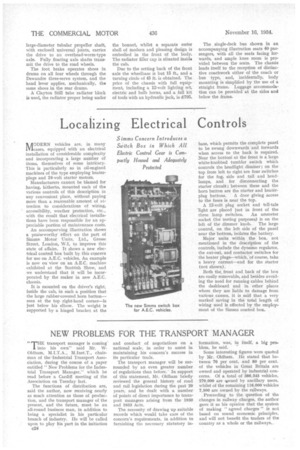Localizing Electrical Controls
Page 90

If you've noticed an error in this article please click here to report it so we can fix it.
Simms Concern Introduces a Switch Box in Which All Electric Control Gear is Corn-. pactly Housed and Adequately Protected
iTODERN vehicles are, in many alcases, equipped with an electrical installation of considerable complexity and incorporating a large number of items, themselves of some intricacy. This is particularly so in oil-engined machines of the type employing heaterplugs and 24-volt starter motors.
Manufacturers cannot be blamed for having, hitherto, mounted each of the various controls of this description in any convenient place, without paying more than a reasonable amount of attention to considerations of wiring, accessibility, weather protection, etc., with the result that electrical installations have been responsible for an appreciable portion of maintenance costs.
An accompanying illustration shows a praiseworthy effort on the part of Simms. Motor Units, Ltd., Grease Street, London, W.1, to improve this state of affairs. It shows a new electrical control box built by this concern for use on A.E.C. vehicles. An example is now on view on an A.E.C. machine exhibited at the Scottish Show,' and we understand that it will be incorporated by the maker in new A.E.C. chassis.
It is mounted on the driver's right, inside the cab, in such a position that the large rubber-covered horn button— seen at the top right-hand corner—is just below his elbow. The weight is supported by a hinged bracket at the base, which permits the complete panel to be swung downwards and forwards when access to the back is required. Near the bottom at the front is a large white-knobbed tumbler switch which controls the headlight dimmer ; on the top from left to right are four switches for the fog, side and tail and headlamps, and for disconnecting the starter circuit; between these and the horn button are the starter and heater plug buttons. A door giving access to the fuses is near the top.
A 12-volt plug socket and tell-tale 'light are placed just in front of the three lamp switches. An ammeter socket (for testing purposes) is on the left of the dimmer knob. The large control, on the left side of the panel near the bottom, isolates the battery.
Major units within the box, not mentioned in the description of the controls, include the dynamo regulator, the cut-out, and contactor switches for the heater plugs—which, of course, take a heavy current—and for the starter (not shown), Both the front and back of the box are easily removable, and besides avoiding the need for running cables behind the dashboard and in other places where they are liable to damage from various causes, it is said that a very marked saving in the total length o'f wiring used is effected by the employment of the Simms control box.




















































































































































































